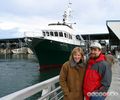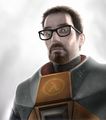The Final Hours of Half-Life 2
| The Final Hours of Half-Life 2 | |
|---|---|
| Author(s) | |
| Language |
English |
| Subject(s) |
Video game design |
| Publisher |
Gamespot |
| Publication date |
November 12, 2004 |
| Pages |
25 |
The Final Hours of Half-Life 2 is an article chronicling the development of Half-Life 2. Written by Geoff Keighley who also authored The Final Hours of Half-Life (2000) and The Final Hours of Portal 2 (2011), it was published on November 12, 2004 on Gamespot. It provides exclusive information about the game's development, and is illustrated with photos of the development team, early screenshots, and concept art.
Contents
Contents[edit]
Images featured in the gallery sections are either taken directly from the article or replaced by higher-quality versions. Some of them appear only in the older versions of the article, viewable by using the Wayback Machine.
Part I: Shock and Awe[edit]
The first, introductory chapter begins with Geoff Keighley describing the day of March 21, 2003, when the decision was made by Gabe Newell to announce the release date of Half-Life 2 — September 30 of the same year — along with its upcoming public debut at E3 2003, declaring that the game would soon enter the final phase of development. The author of the article compares the challenges awaiting Valve that would have to be overcome before Half-Life 2's release to the war in Iraq, which had begun on the same day.
Club Zero[edit]
Set 18 months later, on September 30, 2004, when Valve was preparing for the imminent release of Half-Life 2; with a scanner piñata having been hung in the morning, the development team gathered for one of the last status update meetings, in which members of the Club Zero, i.e. programmers whose levels are devoid of bugs, were to be reviewed. Keighley summarizes the struggles of the 84-person team over the five years of development, mentioning the pressure caused by Half-Life's success, and the disputes with Vivendi Universal Games, Half-Life 2's publisher.
Gallery[edit]
Part II: What's It Going to Take?[edit]
Starts off by chronicling the first few months of Half-Life 2's development, which began in June 1999. It was decided by Valve that the game would not be a simple sequel, innovating the whole genre instead. With loads of money at their disposal, no outside pressure, and a sheer goal of creating a new, original experience, the team began by brainstorming and experimenting with various ideas. It was soon decided that Half-Life 2 would focus on an interactive environment, while expanding on the world and the characters. In order to reach their goal, Valve had to create a new engine.
A Bittersweet Goodbye[edit]
Depicts Mike Harrington's departure from Valve.
Wild Experimentation[edit]
Summarizes the team's attempts at creating a realistic environment: Ken Birdwell's goal of implementing believable animations for human characters, and Jay Stelly's work on interaction-based physics system.
The Hemoglobin[edit]
Concerns Marc Laidlaw and efforts made by the team to continue the story of Half-Life and the way it was told, while setting the sequel in a different location.
Zombie Basketball[edit]
Fast-forward to mid-2001, describing the applications of the new physics engine discovered by the development team, the origins of the first test level for Half-Life 2, and the beginning of the proof-of-concept reel creation process, during which Valve would build different levels showcasing various aspects of the game working together.
Gallery[edit]
Part III: The E3 That Never Was[edit]
Begins by summarizing the team's work on the level reel in the first quarter of 2002, Newell's decision to distance himself from the development process of Half-Life 2 for a few months, and his work on Steam, as well as the presentation of said reel to Newell.
Oh My God[edit]
Describes Newell's reaction to the levels, his decision that Half-Life 2 would not appear at E2 2002, and the disappointment of the development team.
Try, Try Again[edit]
Depicts how Valve accepted the initial failure, and began working on the reel again during the summer of 2002, admitting the fact that the fans would have been disappointed if the existing levels had been shown to them. Keighley points out the similarities between the development of Half-Life and its sequel, noting that in the fall of 1997, the team was also made to scrap most of their work.
The Devil Is in the Details[edit]
Summarizes the improvements made to the reel.
The Cabals Move In[edit]
Describes the cabal system implemented during the development of Half-Life 2 (and its prequel), the level-creating process, the difficulties caused by the fact that the Source engine was being worked on alongside the game, and Newell's decision to ship Half-Life 2 on September 30, 2003.
Gallery[edit]
Part IV: The Potemkin Village?[edit]
Starts off by depicting the E3 2003 presentation and the growing skepticism in the community regarding the September 30 release date.
The Sweater Falls Apart[edit]
Describes Valve's realization that the Half-Life 2 premiere would be delayed, noting the fact that no announcements were made to the public up until almost the very moment of the game's planned release.
Broken Promises[edit]
Depicts the lack of communication between Valve and the community during the summer of 2003, the eventual confirmation by Gabe on September 23 that the game would not be released in a week, and the disappointment of the fans.
Gabe Comes Clean[edit]
Includes Newell's explanation for the way Valve handled the Half-Life 2 release fiasco.
On Top of the Rock[edit]
Describes the day of September 30, 2003, when Newell had to attend a party on Alcatraz Island, rented out by ATI to celebrate the would-be release of Half-Life 2.
Gallery[edit]
Part V: An Unthinkable Crime[edit]
Begins by detailing the day Gabe Newell discovered a security breach in Valve's servers, the subsequent release of the Half-Life 2 source code to the Internet by the hacker in early October 2003, the community reaction to the apparently unfinished state of the game, and the team's concerns about the future of the company.
Picking up the Pieces[edit]
Depicts the severe drop of morale in Valve, and Newell's attempts at keeping the development team focused on finishing the game.
Gallery[edit]
Part VI: Hello, Gabe[edit]
Starts off by outlining the progress made by the team in early 2004, and the improvement of relations between Valve and the community.
I'm Getting My Crowbar[edit]
Describes the day Newell established e-mail contact with the hacker, Valve's plans of bringing him to justice, and the eventual arrest.
Oh My God (Reprise)[edit]
Outlines how it became possible for the first time to play Half-Life 2 from the beginning to the end in March 2004, and the team's reaction to the progress made in the development of the game.
The Home Stretch[edit]
Depicts the atmosphere prevailing in Valve in late July, when Half-Life 2 was entering the final stages of development, and somewhat details the VU Games lawsuits.
Gallery[edit]
By early 2004 tools like Hammer, the game’s editor, were getting easier to use.
Part VII: The Scanner Gets It[edit]
Begins by discussing the day of September 30, 2004, the imminent release of Half-Life 2, and the future projects related to the game.
The Whack Heard Round the World[edit]
Describes the day of October 14, 2004, when the development process of Half-Life 2 officially ended, the celebrations involving whacking a scanner piñata, and the atmosphere of accomplishment prevailing in Valve, overshadowing all of the team's previous concerns.
Gallery[edit]
External links[edit]
- The Final Hours of Half-Life 2 on Gamespot
































































